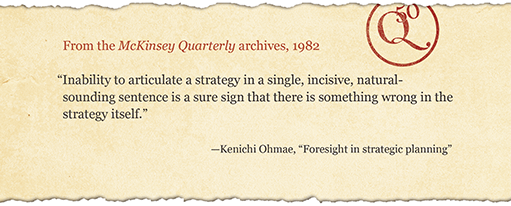Following a recent meeting of the minds among academic, corporate, and McKinsey strategy leaders, three participants offered to pick up the pen and offer further reflections. Fred Gluck, founder of McKinsey’s Strategy Practice and a former managing director of the firm, expounded on the theme of strategic synthesis. Michael G. Jacobides, a professor at London Business School, explored in greater detail areas where he sees opportunities for academics to contribute to the work of practitioners. And Dan Simpson, longtime head of strategy for Clorox and now an executive-in-residence with the Haas School of Business, at the University of California, Berkeley, shared his experience on the thorny issue of matching strategic thrusts with corporate capabilities.
The essence of strategic management
Fred Gluck
Strategies, in my experience, always come from one of three sources: strategic planning, strategic thinking, and opportunistic decision making—with the latter two being the most important.
I think of strategic planning as the job of collecting and analyzing the enormous amounts of data that characterize the modern world and monitoring changes in markets and the competitive environment. This process, which requires frameworks and concepts, is where academics can contribute most in the way of ideas, and strategic-planning groups can add the most value. Strategic planning, defined in this way, provides the raw material and factual basis for strategic thinking and opportunistic decision making.
The next challenge is to synthesize this raw material into what I once called (in a 1978 McKinsey staff paper that was subsequently summarized in the Quarterly) an “integrated set of actions designed to create a sustainable advantage over competitors.”1 In my view, this is the province of CEOs and their top-management teams, and the quality of the synthesis and the effectiveness of the implementation are determined by the quality of the interaction between those teams and the strategic planners. This is the essence of strategic thinking and strategic management: it’s where creativity is paramount and insights take place, and it’s not something that should be limited to an annual strategic-planning process.
Checklists of strategic leverage points—though I prefer the richer notion of “dimensions,” or “strategic degrees of freedom,” as Ken Ohmae called them in his book The Mind of the Strategist—are a powerful means of structuring these discussions and stimulating strategic thinking.

Those involved must gain agreement on what the dimensions are; what, in each dimension, is the second level of strategic degrees of freedom; and what data and analyses are required to shed light on these questions. There are some obvious dimensions: customers, costs, and so on. But new ones are always coming in. You’re more likely to grapple with the right issues if you explicitly take the time to ask along which dimensions should your organization be doing its strategic thinking and engaging in creative debates.
The question then becomes what process continually engages the top-management team in synthesizing and resynthesizing the analyses into both meaningful strategic initiatives and some strategic rules of thumb that can inform opportunistic decision making and continually evolve. A related step in building a robust and insightful approach to managing a company strategically is to engage the board in the process. This must be done in a manner that keeps directors fully informed about the dimensions of the strategy being explored and that provides them with ample opportunity to probe and contribute to the strategic thinking.
Our recent conference in London (see “What strategists need: A meeting of the minds”) began with a lively debate on the paucity of new frameworks for strategy development. We wound up spending a considerable amount of time sharing views on the people and processes that underpin strategy. I thought this was appropriate, and I am hopeful that as the developers of strategic ideas—in academia, corporate strategy departments, and McKinsey—continue pushing the state of the art in response to the changing business environment, they will focus at least as much on tools supporting synthesis and bold responses to unexpected opportunities as on frameworks and planning.
From black swans to grey rhinos: Four ways academics can help managers
Michael G. Jacobides
In his famous book, Nassim Taleb admonished us to beware of “black swans,” disasters so rare that managers disregard them and academic models exclude them—and for which we’re therefore not prepared.
Personally, I think this concern is overdone. The real danger is “gray rhinos”: while hard to miss in the zoo, they are surprisingly difficult to spot in the South African bush, obscured as they are by the vegetation. By the time they’re visible, they are already storming toward you, leaving little chance to react. As academics, our job is to help managers tune into the rustling leaves or cracking twigs of an approaching challenge—or opportunity—before it’s upon them. To do that, we must focus on the parts of the environment that matter most and make sure the tools we carry are fit for the purpose.
A recent roundtable discussion involving leading-edge thinkers and practitioners from business schools, corporate-strategy departments, and McKinsey vividly illustrated both the promise and the challenge of turning academic research into actionable insights. Academics are often criticized—fairly, on the whole—for working in ivory towers far removed from the needs of real-world executives on the ground.2 In my view, we can do a great deal more to realize “gains from trade” between our two worlds, and in this article I set out four areas where that can happen.
How being rigorous helps improve decisions
First and foremost, we need rigor. But there are different types of rigor: the rigor of abstract analytical models, and behavioral rigor, which looks at how individuals, groups, and institutions actually behave. So far, we’ve expected too much from research that might be analytically rigorous but still doesn’t describe reality accurately. I’m thinking particularly of work that comes out of economics, such as game theory or financial economics, which can help but also can obfuscate.
When we confuse beautiful models with messy reality, we all suffer. In the run-up to the financial crisis of 2008, for example, many policy makers deluded themselves into thinking that markets could regulate themselves, while regulators remained blissfully unaware of the business models and structures that had developed in the financial sector. Academics and their models share the blame for these oversights.3
Behavioral work, though, is far more promising. We’re learning more and more about behavioral biases and the way individuals really make decisions. Now we need behavioral and evolutionary economics to step up and show us how organizations make decisions—and why we can expect them, quite predictably, to make bad decisions and to stick with the wrong behavior. The more we know about organizational pathologies, the better the outcomes we can achieve.4
Strategy doesn’t work the way we think it does
The importance of investigating these organizational dynamics speaks to a related issue: as academics, we don’t spend enough time looking at the way strategic decisions are really made. Often, what we call strategy is less about navigating to a distant shore and more about allocating resources among competing projects or people in the here and now. Even our infatuation with innovation may have to do more with making sure the organization keeps its focus on customers (as opposed to internal politics) than it does with new products and services. Strategy acts as a motivating and disciplining device, which helps avoid organizational pathologies.
By leveraging behavioral and evolutionary work, we can get a much clearer picture of the organizational reality of strategy and a better understanding of how to add value through cognitive issues (such as the use of the right frameworks and analogies) and a focus on the most relevant parts of the business environment. And without focusing too much on the negative, we need to understand strategic failure better and to identify the process that drives it.5
Winning doesn’t just mean finishing first
There’s also a growing body of research, in institutional and evolutionary economics and economic sociology, looking at the web of relationships within a sector and in the economy: how complex production systems emerge, evolve, and interact and how value migrates within and between sectors. Whether you call these webs industry architectures, ecosystems, or organizational fields, they’re a lens for viewing reality and can show us some very valuable new perspectives.
These ideas have some big implications for competition—implications that we’re only just beginning to understand. In many sectors, winning doesn’t just mean finishing first; it means changing the rules of the game to your own advantage. Consider how Google and Facebook have redefined the way we interact with information, while also creating ecosystems that collaborate and compete with Apple.6
New landscapes demand new maps
Finally, academics and consultants can come together to revisit popular ideas, even those that have profoundly shaped practice, such as Clay Christensen’s views on disruptive innovation or Michael Porter’s five forces. Models like these are widely used and accepted because they’re user-friendly, make things simpler, and reassure executives that they’ve acted on well-substantiated knowledge.
But should established firms try to be disrupters? Is Porter’s famous model universally applicable? Academic research on such questions is limited, and some of that work suggests the answers are not clear-cut; there are many “ifs” and “buts” that popular frameworks lack. Sadly, though, mainstream academic journals aren’t interested in testing, refuting, or updating strategy frameworks, for all these publications’ stated interest in practical implications. As academics, we can add value by being objective and rigorous about the conditions under which established views do and don’t work well. We can also point out some new, valuable ideas that don’t get enough play in the popular business press and the consulting community.7
In all of these areas, what really excites me is the prospect of a stronger link between practitioners and academics, so we can leverage the research we’ve done and shape the research we need to do. Together, we can simplify reality without distorting it and uncover the social laws that we don’t yet understand but shape our world.
Making capabilities strategic
Dan Simpson
In a recent exchange with a thoughtful group of corporate strategists, academics, and McKinsey strategy leaders, several of us debated the importance of capabilities. Some participants felt that management writing about them had devolved into theoretical gibberish.
I agree there is some gibberish written, but my experience is that capabilities are practical and actionable, and a critical part of strategy. Strong ones create new growth options. Capabilities are also the conduit between strategy and execution, and a failure to assess capabilities objectively is often at the root of execution problems. What, in retrospect, is ascribed to poor execution instead has its roots in an unexpectedly large gap between a company’s capabilities and the ones needed to deliver the strategy successfully.
This gap exists, in part, because of another mismatch: between the rigor of tools and methods for assessing market attractiveness (which are fairly robust, thanks to the contributions of Michael Porter and others) and those for assessing internal skills and capabilities. Frustrated, many organizations make only a cursory attempt to clarify and actively manage their capabilities. In this article, I offer a few suggestions for doing better.
Inventorying internal resources
Resources come in two forms—assets and capabilities—and it’s important not to confuse them. Understanding assets is not that hard. At my former employer, Clorox, brand equities are a huge asset, as are protected technologies, the manufacturing network, and efficient access to retail distribution. A significant portion of Clorox’s value is derived from monetizing those assets in both current and new markets. People-based skills and capabilities can be even larger sources of value, but they are much harder to assess. Three approaches can help:
Get objective inputs
Capabilities are relative, so an external lens is critical. Formal benchmarking is one obvious method. Another is to get honest input on strengths and liabilities from people who know both your company and others well. Customers, suppliers, and industry experts are good sources, as are experienced hires who join from the outside and former employees now working in businesses that don’t compete with yours.
Most companies tend to believe their capabilities are stronger and more distinctive than they really are, but that is not always the case. At Clorox we found a couple of operational areas particularly difficult, leading us to believe we were not that good—but we learned that they were even tougher for others. Excelling was still a challenge, but the outsiders made us realize we had a greater advantage than we had thought. The inverse was true in other areas: capabilities we thought were superior turned out to be just table stakes.
Uncover the logic that separates past successes from failure
Another way to get a more objective view of capabilities is to look back at your company’s most significant successes and failures over, say, a 10- to 15-year period. Write the facts (not the outcomes) of each case on an index card and then try to identify threads of underlying logic that would help people not familiar with the company predict success or failure. With the logic—your capabilities—in hand, people should be able to sort the cards with at least 70 percent accuracy. It’s not a perfect science, but it can help increase objectivity. It’s also a way to see how capabilities change over time.
The output from these two exercises should be not only a robust list of capabilities but also an objective assessment of areas where the organization is not very skilled. If skills in those areas are required to execute a new strategy, realistic plans must be put in place to acquire them.
Go beyond isolated capabilities, to integrated competencies
I define a competency as an integrated set of individual capabilities. In large multibusiness firms, competencies usually exist at the enterprise level. Getting an enterprise view is difficult, though, for two reasons.
The first is that while it’s relatively easy to rise above the business-unit structure, enterprise-level competencies tend to be viewed as areas of functional expertise as opposed to being defined from the customer’s perspective. Customers don’t see functions—they see benefits.
The second reason is that because competencies are complex, it’s hard to be sure you have a real advantage relative to competitors. Some competitors are more capable in one area, while others are more capable in a different one, so you end up with a mixed bag. Interestingly, though, the very complexity that makes it hard to identify competencies is what makes them very hard for others to replicate.
Clorox, for example, has strong capabilities in market segmentation and consumer insights, in retail execution, and in product and packaging innovation. Are any of those world-class in a competitive set that includes P&G and other premier global players? Probably not. However, the combined set—consciously integrated with processes—does give Clorox a clear edge in midsized consumer-goods categories; together, the integrated set forms a competency Clorox called brand building. That competency is superior only in certain contexts, but it did open up opportunities beyond the current portfolio.
Prioritizing and enhancing capabilities
Understanding your capabilities and competencies is important, but it’s not enough. You have to match them to market opportunities and close the gaps.
Use strategy to identify and prioritize capability gaps
In the current businesses, gaps are often fairly obvious, though you need to consider them at both the business-unit and enterprise level. At Clorox, one enterprise gap was how to build consumer desire in a very fragmented media environment quite different from the environment when most of the major brands were built. Filling that gap was a major undertaking. You also have to identify new capabilities that will be needed down the road, in both current markets and new markets the company is considering.
Close gaps with a portfolio approach
The unstated default option to close gaps in large companies is internal development, and that probably is best when long-term proprietary advantage is needed. But it is not the only option—partnerships and acquisitions should be considered as well.
When Clorox added capabilities to make products from natural ingredients—part of a sustainability strategy—it used all three options. Internal development and partnerships played important roles in the development of Green Works natural cleaners, and Clorox acquired capabilities in the formulation of natural personal-care products when it bought Burt’s Bees. Partnerships have become such an important part of Clorox that the company made a conscious choice to develop an internal capability in partnership management.
Make conscious choices on where to disinvest
Reducing investment in capabilities that are no longer as critical to the future is a controversial but often necessary call. Resources for new capabilities need to come from somewhere, and hanging on to outdated capabilities can hamper future performance.
Strategy choices and the capability agenda must match. The sooner and more certainly a new capability will be needed and the larger the gap, the more aggressive you have to be in filling it. If the gap is too large, you probably need to alter the strategy to match a more realistic capability-development plan.
Clarifying and actively managing people-based capabilities is much more complicated and nuanced than this short article implies. But I firmly believe that a robust capability-development agenda isn’t just another corporate priority; it must be inextricably linked with the crafting of strategy.




